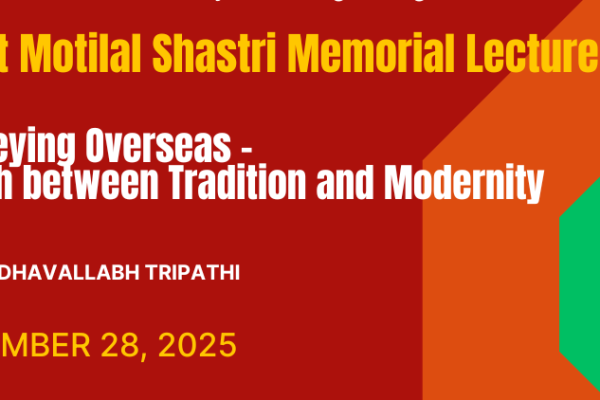Pandit Motilal Shastri Memorial Lecture 2025
Journeying Overseas: A Clash Between Tradition and Modernity Prof. Radhavallabh Tripathi Report In the twentieth century, Pandit Motilal Shastri, a great thinker of Vedic science, became renowned in the world of Sanskrit. By writing over a hundred works in the national language (Hindi), he presented scholars with a new and original perspective. His style of interpretation is entirely novel, and his analysis of technical terms used in Vedic science holds particular importance. Pandit Motilal Shastri himself has provided clear explanations of these expressions. On Sunday, 28 September 2025, the Annual Motilal Shastri Memorial Lecture was held at the Vāchaspati Auditorium of Shri Lal Bahadur Shastri National Sanskrit University, New Delhi. Shri Shankar Shikshayatan celebrates this event annually as a festival of remembrance. During this lecture, the book “Dashavādarahasya: Vaidika Sṛiṣhṭivāda” was released by the invited guests. The book, written in Hindi, was published in 2025 by Vidyanidhi Prakashan, Delhi. It contains a Hindi translation, and detailed commentary on the kārikās of the Dashavādarahasya, along with articles by scholars discussing the doctrine of the “Ten Theories.” In this lecture, Prof. Radhavallabh Tripathi, former Vice-Chancellor of the Central Sanskrit University, New Delhi, delivered an insightful address on the topic Journeying Overseas: A Clash Between Tradition and Modernity. This theme relates to Pandit Madhusudan Ojha’s treatise titled “Pratyantaprasthāna-Mīmāṃsā.” In 1902, Pandit Ojha had accompanied Maharaja Madhav Singh of Rajasthan to England for the coronation ceremony of the British Emperor. At that time, sea voyage (samudra-yātrā) was considered forbidden by the scholarly and priestly community. Upon his return to India, Ojha composed this treatise to examine the relevance and rationale of that prohibition. The Pratyantaprasthāna-Mīmāṃsā consists of three chapters: Prof. Tripathi noted that references to sea voyage occur frequently in the Rigveda, the Smṛitis, in the story of Matsya Avatāra, and throughout Sanskrit literature.He explained that, according to tradition, a person who traveled abroad by sea incurred three kinds of grave sins (mahāpātakas):(1) by undertaking the sea voyage itself,(2) by entering foreign lands, and(3) by associating with non-Vedic peoples (mlecchas). He added that this framework still holds symbolic relevance today—since even now, people do not freely associate, dine, or mingle with everyone. Social distinctions and inequalities in conduct remain visible in society. A quotation from Pratyantaprasthāna-Mīmāṃsā (p. 3) illustrates this point: “For one belonging to the three higher varṇas who has crossed the ocean and reached a frontier land, three kinds of grave transgressions arise: (1) from the very act of sea voyage, (2) from entering border regions, and (3) from contact with the fallen.” At the beginning of the programme, Prof. Santosh Kumar Shukla, Jawaharlal Nehru University, welcomed the assembled guests. He remarked that the observance of social and moral codes varies by region: what is prescribed in one land may not hold in another. For example, marriages between a maternal uncle’s daughter and a nephew are common and accepted in southern India, but prohibited in northern India. Similarly, the rules regarding sea voyage are not uniform everywhere—for the people of northern India, it was traditionally considered completely forbidden. Citing Vidhāna-Pārijāta and other authorities (Pratyantaprasthāna-Mīmāṃsā p. 45), he explained: “Where a custom has been sung or sanctified, it should be practiced only there, not elsewhere. Thus, a maternal-uncle’s-daughter marriage may be valid where recognised, but not in other regions.”“Therefore,” he added, “like such regional customs, the prohibition of sea voyage applied differently across India.” Shri Rajeshwar Shukla, Principal Judge of the Family Court, Gorakhpur, addressed the gathering as the Chief Guest. He said, “It is necessary for us to understand the ancient laws and rules that shaped our society. To study ancient ideas today is itself modernity. The ancient knowledge is our tradition; modernity lies in revisiting and reinterpreting it. The harmony between the two expands our understanding.” Prof. Bhartendu Pandey, Head of the Department of Sanskrit, University of Delhi, presided over the session. He opened the discussion by referring to the Pratyantaprasthāna-Mīmāṃsā and observed that different scholars explained the prohibition of sea voyage in the Kali age in various ways:(a) some accepted it as a general scriptural injunction;(b) some based it on emotional or ritual attachment;(c) some viewed it as dependent on the possibility of moral corruption or social fault;(d) and some saw it as a practical limitation for those lacking means or strength to perform the journey safely. The text itself (p. 22) states: “Not all prohibitions operate everywhere and for all. Some arise from general scriptural rules, some from attachment, others from observed faults or dangers, and still others from inability or limitation. Hence, exceptions are made in specific contexts.” At the beginning of the event, Prof. Sundar Narayan Jha of Lal Bahadur Shastri National Sanskrit University recited the Vedic Mangalacharan, and Prof. Mahanand Jha offered the classical (laukika) Mangalacharan.The programme was conducted by Dr. Mani Shankar Dwivedi, Guest Lecturer in Sanskrit at Jamia Millia Islamia University. Dr. Lakshmikant Vimal, Research Officer of Shri Shankar Shikshayatan, delivered the vote of thanks. Scholars, teachers, research students, and Sanskrit enthusiasts from Delhi University, Jawaharlal Nehru University, Lal Bahadur Shastri National Sanskrit University, and Jamia Millia Islamia participated enthusiastically, contributing to the success of the event.

